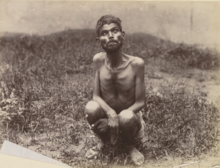Dina Sanichar

Dina Sanichar (1860 or 1861–1895) was a feral boy. A group of hunters discovered him among wolves in a cave in Bulandshahr, Uttar Pradesh, India in February 1867,[1] at the age of around six.[2][3][4][5]
Sanichar was sent to the Secundra orphanage at Agra where he lived among other humans for over twenty years. He never learned to speak and remained seriously impaired his entire life.
Discovery[edit]
Dina Sanichar was discovered in a cave in the district of Bulandshahr and was brought to the local district magistrate and collector.[6][7] He was subsequently sent to the Secundra orphanage at Agra.[6][8]
At the orphanage[9] he was given the name Sanichar (meaning Saturday) because he arrived on a Saturday.[10] It was reported that he initially walked on all fours and ate raw meat.[11] While he could not speak, he would make sounds similar to a wolf.[3] He went on to live among other humans for over twenty years but never learned to speak, and remained seriously impaired his entire life.[4][12] Sanichar was a heavy smoker.[13]
Death and legacy[edit]
He died of tuberculosis in 1895 around the age of 34.[9]
Sanichar may have been the inspiration for the character Mowgli in The Jungle Book by Rudyard Kipling.[14]
References[edit]
- ^ Kaul, Ikbal (1978-10-15). "During the last century, nearly 50 cases of wolf children reported in India". India Today. Archived from the original on 2021-01-20. Retrieved 2021-04-07.
- ^ Degregory, Lane (2008-08-03). "Feral children through the ages". www.tampabay.com. Archived from the original on 2017-11-17. Retrieved 2021-04-07.
- ^ a b Mathur, Priyanshi (2018-12-10). "Meet The Real-Life Mowgli – Dina Sanichar Who Was Raised By A Pack Of Wolves". IndiaTimes. Archived from the original on 2018-12-10. Retrieved 2021-04-07.
- ^ a b Malson, Lucien (1972). Wolf children and the problem of human nature. New York and London: Monthly Review Press. p. 45. ISBN 9780902308244.
- ^ Ferris, George C. (3 June 1902). Sanichar the Wolf-Boy of India (PDF). New York City. p. 20.
{{cite book}}: CS1 maint: location missing publisher (link) - ^ a b Notes and Queries. Oxford University Press. 1886. p. 178.
- ^ Ha, James C.; Campion, Tracy L. (2018). Dog Behavior: Modern Science and Our Canine Companions. Academic Press. ISBN 978-0-12-816746-5.
- ^ "Wolf boys". North British Advertiser & Ladies' Journal. 5 September 1885. p. 3.
- ^ a b "Legendary wildlife conservators and jungle lore". The Statesman. 2013-11-06. Retrieved 2021-04-07.
- ^ "Real story of Mowgli Netflix Movie: Who was Mowgli. The Jungle Book character & how did it inspire Netflix's 2018 Hindi movie Mowgli". GQ India. 7 December 2018. Retrieved 2021-04-07.
- ^ Wyness, Michael (2018-06-27). Childhood, Culture and Society: In a Global Context. Sage. ISBN 978-1-5264-2250-7.
- ^ Zingg, Robert M. (1940). "Feral man and extreme cases of isolation". The American Journal of Psychology. 53 (4): 487–517. doi:10.2307/1417630. JSTOR 1417630.
- ^ Malson, Lucien (1972). Wolf Children. NYU Press. ISBN 978-0-85345-264-5.
- ^ Sorabji, Caroline (1904). The Wide World Magazine: An Illustrated Monthly of True Narrative, Travel, Customs, and Sport. George Newnes. p. 38.
